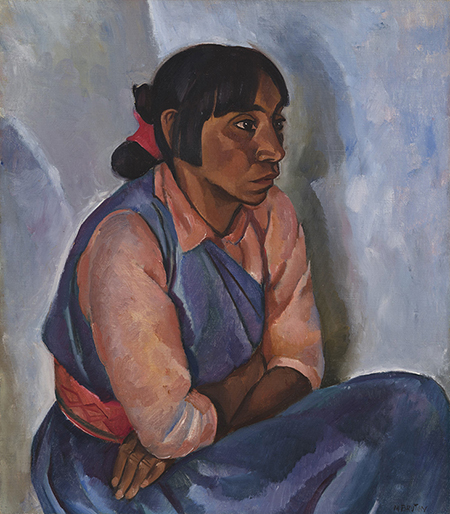
Continuing through May 6, 2023
Unknown to most people today, the Bruton Sisters were three immensely talented artists who grew up in the early 20th century in comfort, style, and great affluence. Margaret (1894-1983), Esther (1896-1992) and Helen (1898-1985) began creating work as young children, taking over the family’s expansive attic in Alameda, California, for their studio — with the encouragement of their mother.
The “best friends” sisters, who made art professionally from the 1920s to the 1960s, got along amazingly well, supporting each other in their experimentation with a variety of styles, materials, and techniques. None of the three had children; only Esther married (in 1941) They often lived, studied (in the U.S. and Paris), and traveled together. Helen is reported to have remarked, “When one would start something, we would all do the same thing.”
Coming of age when modernism was flourishing amidst the extravagant parties of the roaring twenties, the tall, blonde, attractive sisters engaged in the best that the art world and life of that era had to offer. In sync with their time, their work reveals wide-ranging experimentation, while their individual art pieces reflect their influences on each other, along with combined creative efforts.
This exhibition includes 18 pieces from Langson IMCA’s permanent collection, with loans from private collections and the Monterey Museum of Art. It’s the first exhibition of their work in a half century. Curator Wendy Van Wyck Good — author, archivist, historian — explains that the work demonstrates the sisters' impact on the development of California Modernism. She adds that their fame waned as the times changed, and that, “After World War II, their popularity began to decline and, unfortunately, they were largely forgotten by the 1980s.”
Each sister had her particular media and styles. Margaret is known for paintings and later for her abstractly designed terrazzo tabletops and counters. Esther was involved with the decorative arts, including screens and murals. Helen created mosaics for, among other clients the Works Progress Administration. The sisters, who won many awards, also collaborated on large-scale public art commissions, including “The Peacemakers” mural for San Francisco's Golden Gate International Exposition in 1939 (later demolished).
In the first gallery, Margaret’s country landscape “Barns on Cass Street” (1925) displays elements of abstraction and hints of cubism with its expressive brushstrokes, flat blocks of color and geometric forms. Her more abstract “The Harmonica” (1935) illustrates a worker from the Depression era with large, powerful hands and a cap, but no harmonica. “Taos Woman” (probably 1929) is a portrait of an indigenous woman, slumped over, staring into the distance. This powerful painting is evocative of portraits by Diego Rivera, whom Margaret met when he visited the Bay Area.
In the late 1930s, Margaret gave up painting to create terrazzo tabletops. These include her abstract “Untitled (biomorphic terrazzo)” and “Untitled (geometric terrazzo),” both circa 1950s, mounted onto the wall for this show. Composed of bent metal wires, hard-edge and curvilinear forms, these pieces display biomorphic shapes in muted grays, blues, pinks, and oranges. They became more popular than the artist’s earlier paintings, a testament to the demand for decorative arts at that time.
Many of Esther’s murals have been destroyed, but preliminary studies survive. Her “Plan for the I. Magnin mural” (circa 1939), made with gouache and gold and silver paint on pewter colored Chinese paper, provides only a hint of what these murals looked like. An extant three-panel screen, “Rabbit Hunt” (1929), made of gold and aluminum leaf and eggshell mosaic, was inspired by a visit to Taos. The panel illustrates Native Americans on horseback hunting rabbits. Formal features include bold shapes, flat areas, and lines suggesting movement and energy. Its muted color palette and gold leaf evoke the desert landscape.
Inspired by her sisters’ unbridled creativity, the youngest, Helen, began making intricate mosaic art pieces in the 1930s. These works were so admired for their ancient Greek and Roman techniques with Cubist and abstract designs that she became one of California’s most acclaimed mosaicists. Her “Woman with Turquoise Bracelet” (before 1935), an image of a woman admiring her bracelet, contains the flat blocks of color and geometric forms of modernism. “Three Faces on Gold” (ca. 1940) is a striking ceramic mosaic with Picasso-like faces. “Untitled (Lulu mosaic)” (nd) echoes mid-20th century Abstract Expressionism.
Several other pieces by Helen exhibit experimentation with styles and mediums. These include linoleum block prints, abstract designs for tabletops and figurative exhibition flyers. Her linoleum block “The Party” (1925), created when she was a young party girl, is a roaring twenties scene of couples dancing seductively.
This comprehensive exhibition also contains pieces in Langson IMCA’s collection by other artists who worked during the Bruton Sisters’ heyday. Work by Henrietta Shore, Mabel Alvarez, Jessie Arms Botke and several others demonstrates how artists — especially women artists — of that time, including the Brutons, engaged with and were inspired by each other.
